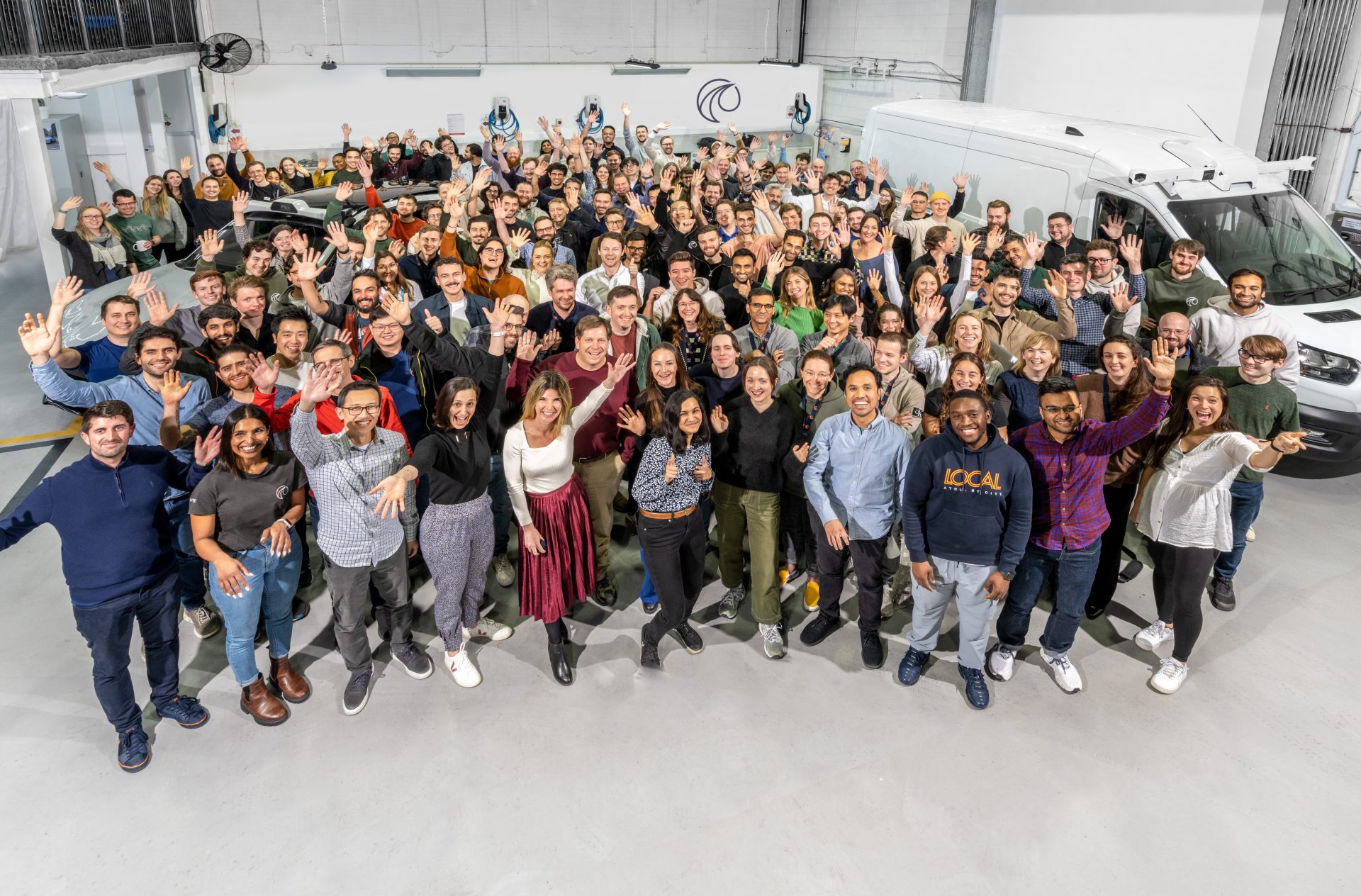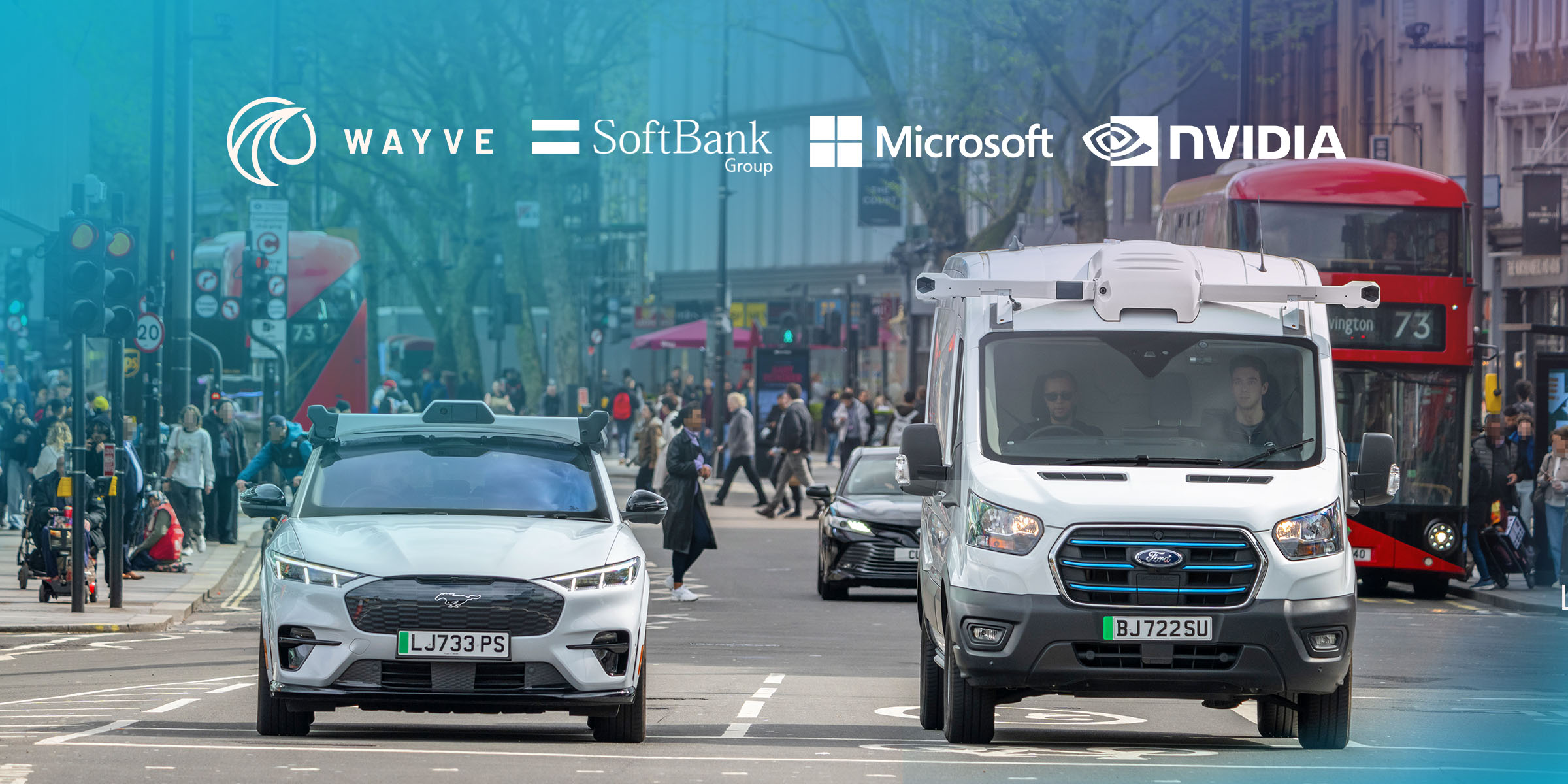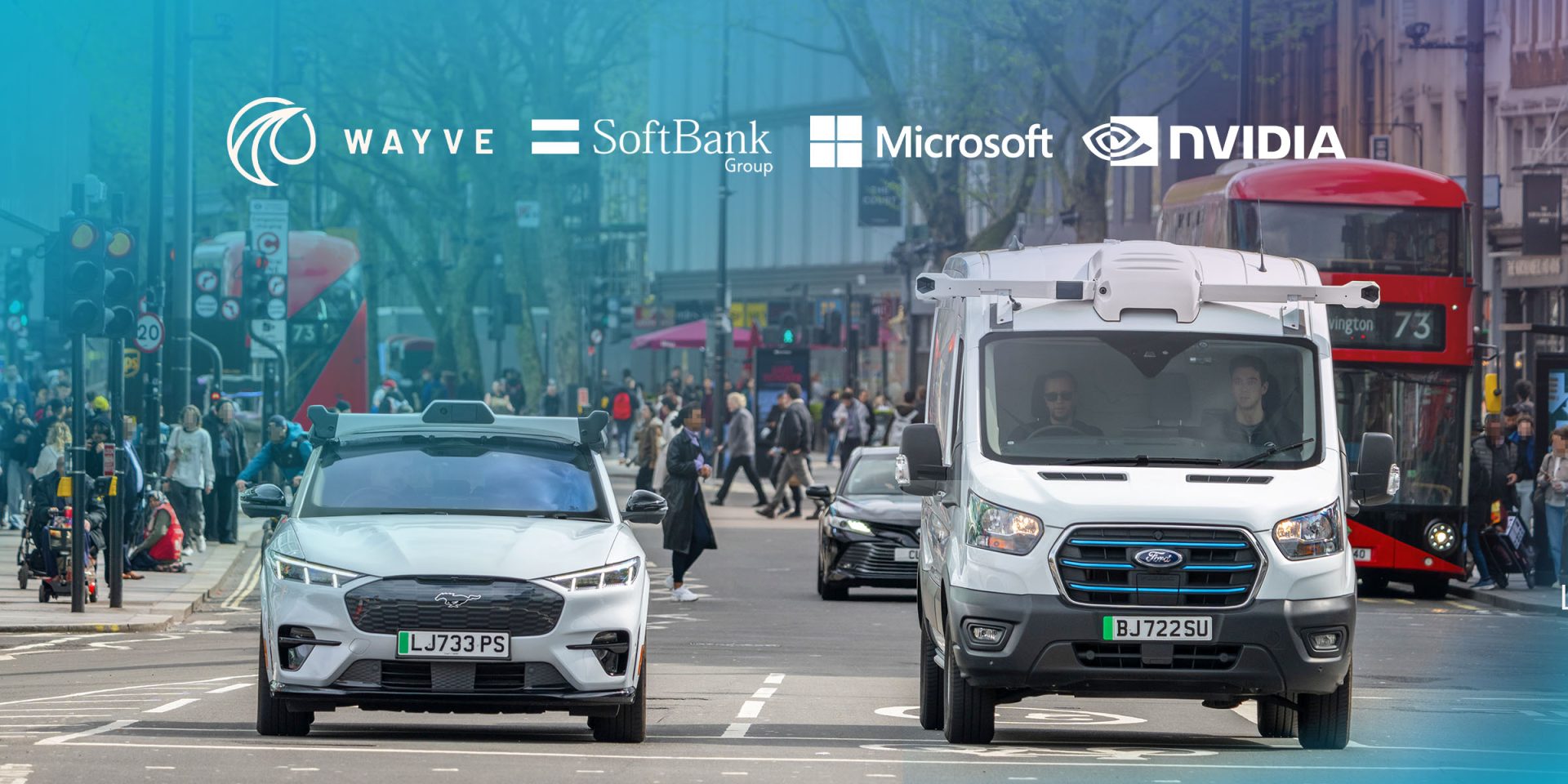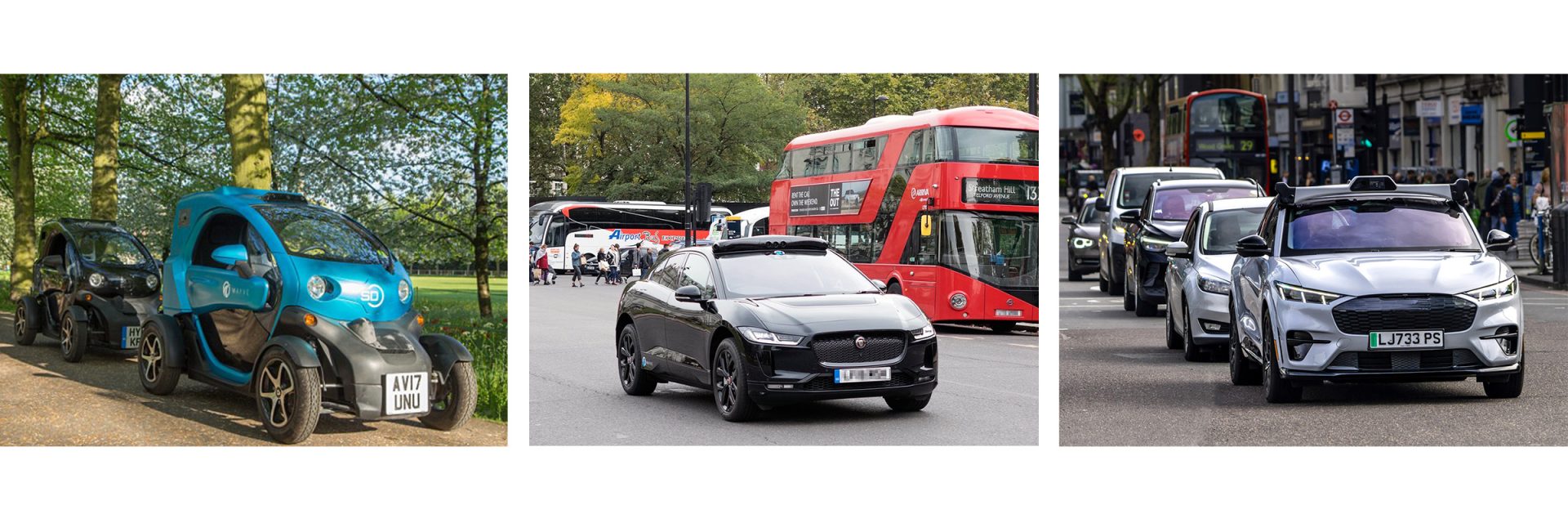Information
Technology AV2.0 Fleet learning loop Safety 2.0 framework Product Wayve AI Driver Fleet solutions Meet our fleet Science GAIA LINGO CVPR 2024 WayveScenes101 Careers Our people Our journey Diversity, Equity & Inclusion Join us Company Leadership Locations Investors Data Privacy Blog Company blog Company news Press kit Technology AV2.0 Fleet learning loop Safety 2.0 framework Product Wayve AI Driver Fleet solutions Meet our fleet Science GAIA LINGO CVPR 2024 WayveScenes101 Careers Our people Our journey Diversity, Equity & Inclusion Join us Company Leadership Locations Investors Data Privacy Blog Company blog Company news Press kit | 14 minute read C-3PO Star Wars, Disney. WALL-E, Disney/Pixar. K.I.T.T., Universal Television. Marvin the Paranoid Android, Walt Disney Pictures. C-3PO Star Wars, Disney. WALL-E, Disney/Pixar. K.I.T.T., Universal Television. Marvin the Paranoid Android, Walt Disney Pictures. Three different vehicles retrofit with Wayve's autonomous vehicle technology Three different vehicles retrofit with Wayve's autonomous vehicle technology Each breakthrough has been driven by the area with the most impactful and challenging data at the time. This is why Embodied AI is emerging as the next frontier. Language and vision datasets are saturating, turning to multi-modality like vision language models to find more data, and Cognitive AI technology is focusing on commercial exploitation. In contrast, Embodied AI continues to be propelled by autonomous driving because of its unique challenges and opportunities, going beyond fields like language and vision: Cybernetic Tortoise (1950), Shakey the Robot (1966), WABOT-1 (1973), ALVINN (1989) Cybernetic Tortoise (1950), Shakey the Robot (1966), WABOT-1 (1973), ALVINN (1989) Wayve's prototype robot vehicles: Twizzy (2017), Wayve Gen 1 (2019), Wayve Gen 2 (2024) Wayve's prototype robot vehicles: Twizzy (2017), Wayve Gen 1 (2019), Wayve Gen 2 (2024) This approach, typically adopted by AV1.0 robotaxi services, has cost over $100 billion without clear economic viability or substantial revenue. While the technology is impressive, the cost reduction, viable unit economics, and manufacturing challenges remain unsolved. This approach leverages software-defined vehicles to integrate Embodied AI into existing ADAS to generate revenue, collect data, and build consumer trust. This paves the way to train and validate full autonomy with data from a global install base—incrementally growing ‘eyes off’ driving capabilities by delivering over-the-air updates to vehicles to upgrade their driving automation levels and facilitate the transition to a driverless future. viable AI-driven solution to accelerate the transition from driver assistance systems to full autonomy, partnering with leading automotive OEMs and fleets to integrate our technology into their existing products. Importantly, we provide OEMs with expertise in deploying end-to-end deep learning models in safety-critical environments. Our technology can support NCAP and GSR active-safety test protocols as part of our comprehensive automated-driving safety architecture and is FuSa -compliant by design while also offering unprecedented driving flow, utility, and safety . The automotive industry has begun deploying vehicles capable of over-the-air updates and extensive fleet data collection. Comprehensive, redundant camera and radar sensing are becoming standard across premium vehicles and are expected to be included in all models soon. Devices like NVIDIA Orin or Thor now provide the necessary computational power (TOPS) to run large AI models directly on the vehicles. AI has the expressive power to learn from petabytes of data and generalize to scenarios not previously encountered in training. The automotive industry has moved past the skepticism of the ‘trough of disillusionment’ and is now actively competing over the new battleground of autonomy. Notably, this strategy remains unattainable for AV1.0 technology, which requires computing and sensor arrangements that are currently too complex and costly for mass-production consumer vehicles. By tackling the challenges in autonomous driving, we advance AI technology and pave the way for smarter, safer Embodied AI applications across various industries. Our strategy is clear, and we are now thrilled to announce new investment which will propel us forward. We are thrilled to announce our Series C with SoftBank Group, NVIDIA, and Microsoft . This round was led by SoftBank Group. Masayoshi Son, Chairman and CEO of SoftBank Group, is an incredible visionary and entrepreneur. His deep belief and commitment to AI and robotics align perfectly with our long-term goals. Microsoft and NVIDIA are two of the largest companies in the world, but more importantly, their conviction in AI has had a profound impact on shaping this emerging industry. We are pleased to welcome SoftBank Group and NVIDIA as new shareholders and appreciate Microsoft for increasing their investment in Wayve. With the support of visionary investors and strategic partners, we are poised to accelerate our Embodied AI product. Our collaboration with Microsoft and NVIDIA, leveraging Microsoft Azure to scale our AI models and advanced embedded computing platforms like NVIDIA Drive Orin and Thor, underscores our commitment to leading the AI-driven transformation in automotive technology. With this new capital, we begin a new chapter in turning our Embodied AI technology into impactful commercial products. Our immediate plans include launching our first product featuring L2+ ADAS, marking a significant opportunity for consumer vehicles. This will be just the first step on our journey, and we continue to deepen our investments in talent, computing, and data infrastructure to advance Embodied AI science. Ultimately, this will enable a rich ecosystem of Embodied AI products, enabling Level 5 autonomous vehicles and much more. Wayve has been deliberate in building a culture that brings together the most mission-driven, globally diverse, and exceptional group of people to create Embodied AI. This is a truly cross-functional problem, and we strive to build an environment that lets our people at Wayve do the work that defines their careers. We continue to invest heavily in ground-breaking Embodied AI science while also growing the rigorous and collaborative engineering culture to ship Embodied AI products to delight the world. We feel honored to be among the few deep tech companies with the opportunity to transform our technology into a product that delights the world. With solid foundations of capital, culture, computing, and data in place, we are excited to collaborate with the world’s leading and most innovative automotive manufacturers and fleet operators to enable a next-generation driving experience with AI. Our team is expanding in our offices around the world. If you share our vision, please reach out! wayve.ai/careers | rr rr r r | rr rr r r | rr rr r r rr rr r r rr rr r r Necessary Analytics Embedded rr rr r r rr rr r r Pioneering Embodied AI for Autonomy Next-gen autonomous driving technology based on end-to-end AI Training, evaluating and deploying foundation models for autonomy Embracing a new paradigm in AV safety Advanced AI technology for safer, smarter driving Enabling automakers to unlock all levels of driving automation at scale Wayve AI Driver for last-mile delivery and ridehail Data collection and development vehicles for assisted and automated driving Advancing end-to-end autonomous driving research Generative AI world model that can generate realistic driving videos from text Using natural language to train and explain AI driving models Join Wayve at CVPR 2024. Don’t miss our tutorial on end-to-end autonomy. Publicly available benchmark dataset to support advancing novel view synthesis models Wayve is a place where you can shape the future of autonomous mobility Learn more about our team and why they joined Wayve How we started and where we are today We strive to create a more equitable world All of our current open roles We are proudly reimagining autonomous mobility Meet the people leading Wayve See where Wayve operates We’re proud to be backed by investors who share our vision How we protect individuals’ data Insights. Ideas. Research. Stay up-to-date with what’s new at Wayve Access branding elements, images and videos for press Pioneering Embodied AI for Autonomy Next-gen autonomous driving technology based on end-to-end AI Training, evaluating and deploying foundation models for autonomy Embracing a new paradigm in AV safety Advanced AI technology for safer, smarter driving Enabling automakers to unlock all levels of driving automation at scale Wayve AI Driver for last-mile delivery and ridehail Data collection and development vehicles for assisted and automated driving Advancing end-to-end autonomous driving research Generative AI world model that can generate realistic driving videos from text Using natural language to train and explain AI driving models Join Wayve at CVPR 2024. Don’t miss our tutorial on end-to-end autonomy. Publicly available benchmark dataset to support advancing novel view synthesis models Wayve is a place where you can shape the future of autonomous mobility Learn more about our team and why they joined Wayve How we started and where we are today We strive to create a more equitable world All of our current open roles We are proudly reimagining autonomous mobility Meet the people leading Wayve See where Wayve operates We’re proud to be backed by investors who share our vision How we protect individuals’ data Insights. Ideas. Research. Stay up-to-date with what’s new at Wayve Access branding elements, images and videos for press 7 May 2024 | Leadership A perspective from Alex Kendall, Co-founder & CEO of Wayve, on how we are pioneering the future of autonomous technology and poised to launch our first Embodied AI product. Since our inception, we have held a core belief that end-to-end AI will make autonomy possible. This has been a deeply contrarian approach against the rest of the market, and we are excited to see our progress and this funding as a massive endorsement of our vision. This blog reflects why Wayve is at a pivotal moment and how this Series C investment from our new partners, SoftBank Group and NVIDIA, and our existing partner, Microsoft, will enable Wayve to ship our first Embodied AI automotive product. Today’s excitement for AI often centers around Cognitive AI, like large language models. They are an amazing breakthrough and will have a huge impact on our lives. But they are still limited by the domain they act within — words, data, and knowledge, an abstracted reality. The reality we live in is the physical world, and this is where our most significant interactions take place. This is what Embodied AI enables, bringing the extraordinary impact of AI to the physical world. Embodied AI is poised to become the most valuable application of AI, promising to transform our interaction with technology. This will usher in a new era of technology that will be more impactful than any that came before it. Cognitive AI only unlocks a fraction of the ultimate potential of AI. Looking ahead 20 years from now, if you ask someone about AI, most people will associate it with physical robots that enhance their lives, like robots that perform household chores or self-driving cars. These applications are often depicted in science fiction and are examples of Embodied AI. At Wayve, we are creating Embodied AI technology that will enable applications like autonomous vehicles to enhance our daily lives by safely coexisting with humanity and allowing people to concentrate on what truly matters. Autonomous driving is a grand challenge of AI and will be the first large-scale deployment of Embodied AI. But of course, the opportunity for Embodied AI is much larger, so why start here? From a technical perspective, we’ve observed the evolution of AI driven by various fields over the last decade: Language and vision datasets are saturating, turning to multi-modality like vision language models to find more data, and Cognitive AI technology is focusing on commercial exploitation. In contrast, Embodied AI continues to be propelled by autonomous driving because of its unique challenges and opportunities, going beyond fields like language and vision: 1. Autonomous driving unlocks globally diverse data at a massive scale. Video, radar and LiDAR data already amount to several times the petabytes of all language data in the world. Every year, millions of vehicles are built with the necessary sensing and compute for training and deploying Embodied AI. These vehicles are already being driven today doing useful work, meaning that data collection can be achieved with low operational cost, unlike with other robotics applications. These vehicles are being operated around the world and experience open-set, unconstrained environments, rich with the long tail of edge cases. 2. Autonomous driving demands a solution to AI safety. The autonomous driving domain is a major driver of AI safety innovation, pushing AI systems to handle complex, unpredictable real-world scenarios. Level 5 autonomous driving will operate in an open-world setting, arguably requiring general purpose, unbounded reasoning. This safety-critical challenge calls for AI systems to achieve unparalleled levels of safety. Other forms of AI, like closed-warehouse operations or online generative content, lack these rigorous safety demands and are less motivated to address them. Success in Embodied AI hinges on achieving acceptable levels of trust and safety, and autonomous driving provides the ultimate motivation. 3. Autonomous driving brings a viable business model: The autonomous driving market offers significant commercial potential, projected to exceed $100 billion with Advanced Driver Assistance Systems (ADAS) even before full autonomy is reached. This is a sector that can support steady technological advancements and business growth, introducing AI-powered driving automation gradually to build consumer acceptance and trust over time, even prior to Level 4 deployment. 4. Autonomous driving offers valuable societal benefits: Each year, approximately 1.2 million people die in traffic accidents, with another 20 to 50 million suffering from non-fatal injuries, many leading to disabilities. Autonomous driving offers the chance to keep the benefits of cars while significantly reducing or even eliminating the costs we pay for these benefits. Moreover, by implementing Embodied AI in active safety systems, such as ADAS, we can enhance road safety even before autonomy is reached, by providing essential support to drivers. The autonomous driving domain is a major driver of AI safety innovation, pushing AI systems to handle complex, unpredictable real-world scenarios. Unlike autonomous driving, which can tap into millions of vehicles, other forms of Embodied AI, like manufacturing or humanoid robotics, often lack existing install bases or compelling business models. Road vehicles are already being utilized worldwide today which enables fleet-scale data collection without extraordinary capital cost. Also, simpler pick-and-place robotics tasks in controlled warehouse environments are like self-driving’s focus on the most simple environments in Phoenix, Arizona, 5 years ago. It results in a solution set that simply doesn’t scale to a general setting and diminishes the urgency to advance AI capabilities. This makes autonomous driving the ideal sector to pioneer a general-purpose Embodied AI foundation model. Developing large language models in software environments is faster than real-world testing. Yet, without real-world experience, AI may struggle with physical interface challenges, miss out on valuable training data, and overlook critical safety and system integration issues. Our experience shows that full AGI isn’t required to start providing value in Embodied AI and autonomous driving technology can already save millions of lives today. It’s feasible and beneficial to develop these technologies concurrently. By tackling the challenges in autonomous driving, we advance AI technology and pave the way for smarter, safer Embodied AI applications across various industries. But where did Embodied AI begin? Embodied AI has a rich history that predates Wayve, marked by several key milestones: ALVINN was ahead of its time. Unfortunately, post ALVINN, both academic and commercial focus in robotics shifted toward non-machine learning approaches that initially relied on hand-coded rules and today continue to depend on heavyweight sensing, perception, and high-definition (HD) maps. This was epitomized by the DARPA Grand Challenges from 2004-2007 and the subsequent commercialization by Google Self-Driving Car Project, now known as Waymo. Wayve’s “Learning to drive in a day”: the first example of reinforcement learning on-board an autonomous car. Recently, the capabilities of large language models and Generative AI have expanded dramatically, beginning with OpenAI’s ChatGPT. In 2023, Tesla shifted its technical strategy to embrace end-to-end learning with the release of FSD v12. We’re also starting to see the industry explore non-driving Embodied AI applications like Tesla’s Optimus and Covariant’s RFM-1. These milestones showcase the technological evolution and broadening scope of Embodied AI, from basic mechanics to complex, interactive systems. After nearly 2 decades since the first DARPA Grand Challenge, which ignited the development of self-driving cars, it feels like progress has stalled. Despite $100B+ investment, millions of miles of on-road testing, and billions of miles of simulated driving, the industry still feels far from realizing the future of safe, sustainable, and accessible self-driving cars. A few tech giants have been able to demonstrate self-driving in very limited scenarios but drop their autonomous vehicles in new driving domains, and they struggle. As industry hype begins to dissipate, the challenge is becoming even clearer: the classic robotics approach—known as AV1.0, which relies on complex sensors, labor-intensive HD mapping, and hand-coded rules—is proving to be increasingly cumbersome and cost-prohibitive to build. The technology gap that remains is behavior prediction and planning, especially around safely handling the long tail of rare ‘edge case’ events, which will only be solved by greater intelligence. Since 2017, we have pioneered AV2.0, a next-gen autonomous driving system capable of quickly and safely adapting to new driving environments worldwide. Our technology excels where others have struggled: mastering driving in complex urban environments with camera-only navigation and adapting to cities unseen during training just like how you and I drive. Such achievements require a willingness to disrupt legacy thinking and try brave new solutions. Key Features of AV2.0: Beyond overcoming the technical hurdles, the industry still faces unresolved challenges in turning AV technology into a marketable product on a global scale. Two strategies have emerged: 1. Start with a constrained environment and brute force the solution with expensive sensors and mapping infrastructure. This approach, typically adopted by AV1.0 robotaxi services, has cost over $100 billion without clear economic viability or substantial revenue. While the technology is impressive, the cost reduction, viable unit economics, and manufacturing challenges remain unsolved. 2. Create a scalable solution capable of operating globally and progressively increasing the level of driving automation. This approach leverages software-defined vehicles to integrate Embodied AI into existing ADAS to generate revenue, collect data, and build consumer trust. This paves the way to train and validate full autonomy with data from a global install base—incrementally growing ‘eyes off’ driving capabilities by delivering over-the-air updates to vehicles to upgrade their driving automation levels and facilitate the transition to a driverless future. We are focusing on deploying a scalable and financially viable AI-driven solution to accelerate the transition from driver assistance systems to full autonomy, partnering with leading automotive OEMs and fleets to integrate our technology into their existing products. Importantly, we provide OEMs with expertise in deploying end-to-end deep learning models in safety-critical environments. Our technology can support NCAP and GSR active-safety test protocols as part of our comprehensive automated-driving safety architecture and is FuSa-compliant by design while also offering unprecedented driving flow, utility, and safety. Notably, this strategy remains unattainable for AV1.0 technology, which requires computing and sensor arrangements that are currently too complex and costly for mass-production consumer vehicles. Watch Wayve’s Embodied AI technology navigate the complexities of real world driving. By tackling the challenges in autonomous driving, we advance AI technology and pave the way for smarter, safer Embodied AI applications across various industries. Our strategy is clear, and we are now thrilled to announce new investment which will propel us forward. We are thrilled to announce our Series C with SoftBank Group, NVIDIA, and Microsoft. This round was led by SoftBank Group. Masayoshi Son, Chairman and CEO of SoftBank Group, is an incredible visionary and entrepreneur. His deep belief and commitment to AI and robotics align perfectly with our long-term goals. Microsoft and NVIDIA are two of the largest companies in the world, but more importantly, their conviction in AI has had a profound impact on shaping this emerging industry. We are pleased to welcome SoftBank Group and NVIDIA as new shareholders and appreciate Microsoft for increasing their investment in Wayve. With the support of visionary investors and strategic partners, we are poised to accelerate our Embodied AI product. Our collaboration with Microsoft and NVIDIA, leveraging Microsoft Azure to scale our AI models and advanced embedded computing platforms like NVIDIA Drive Orin and Thor, underscores our commitment to leading the AI-driven transformation in automotive technology. With this new capital, we begin a new chapter in turning our Embodied AI technology into impactful commercial products. Our immediate plans include launching our first product featuring L2+ ADAS, marking a significant opportunity for consumer vehicles. This will be just the first step on our journey, and we continue to deepen our investments in talent, computing, and data infrastructure to advance Embodied AI science. Ultimately, this will enable a rich ecosystem of Embodied AI products, enabling Level 5 autonomous vehicles and much more. Wayve has been deliberate in building a culture that brings together the most mission-driven, globally diverse, and exceptional group of people to create Embodied AI. This is a truly cross-functional problem, and we strive to build an environment that lets our people at Wayve do the work that defines their careers. We continue to invest heavily in ground-breaking Embodied AI science while also growing the rigorous and collaborative engineering culture to ship Embodied AI products to delight the world. We feel honored to be among the few deep tech companies with the opportunity to transform our technology into a product that delights the world. With solid foundations of capital, culture, computing, and data in place, we are excited to collaborate with the world’s leading and most innovative automotive manufacturers and fleet operators to enable a next-generation driving experience with AI.Our team is expanding in our offices around the world. If you share our vision, please reach out! wayve.ai/careers 10 March 2025 | Engineering Wayve’s expansion into the US and Germany showcases AV2.0’s ability to quickly adapt to new driving environments with minimal data. This blog highlights real-world results demonstrating how Wayve’s foundation model generalizes across diverse geographies and vehicle platforms, advancing the vision of a truly global AI Driver. 7 January 2025 | Partnerships Wayve’s collaboration with NVIDIA drives innovation in AI-powered mobility, advancing scalable AI solutions for the automotive industry and accelerating the ... 9 December 2024 | Life at Wayve A perspective from Alex Kendall, Co-founder & CEO of Wayve, on how the company’s new values reflect the exciting transition we’re making—from being a pioneering deep-tech company to delivering transformative products at scale. Headquarters, UK230-238 York WayLondon, N7 9AGUnited Kingdom +44 20 4574 5971 hello@wayve.ai









